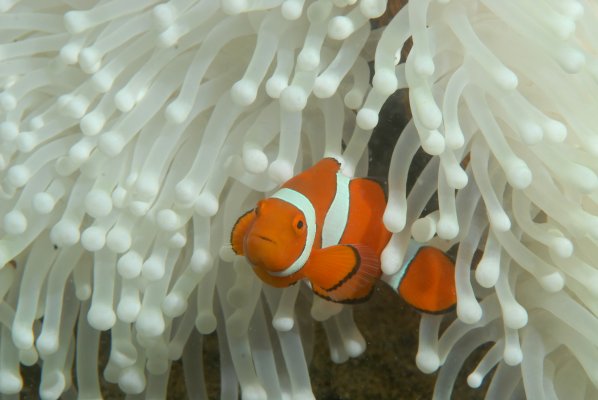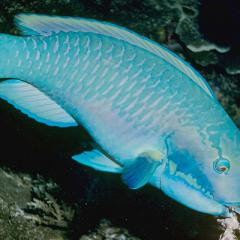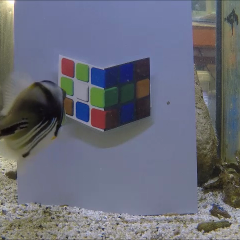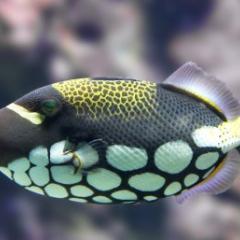Podcast: Coral bleaching in the Great Barrier Reef
This episode the grey matter in question is not, in fact, the brain, but the bleached corals of the Great Barrier Reef. Professor Justin Marshall leads the Sensory Neurobiology laboratory at the Queensland Brain Institute. He talks about working with Sir David Attenborough, the citizen science project Coral Watch, and the unprecedented coral bleaching that is unfolding on the Great Barrier Reef.

Losing nemo: QBI's Professor Justin Marshall discusses climate change and coral bleaching in the Great Barrier Reef. (Image: Justin Marshall / QBI)
Read more about Professor Marshall's research or Coral Watch.
Transcript
Kirsten: Hi, I'm Kirsten MacGregor and you're listening to ‘A Grey Matter’. The neuroscience podcast from the Queensland Brain Institute. This week, “The Grey Matter” in question is not in fact the brain but the bleached corals of the Great Barrier Reef. Professor Justin Marshall heads up the sensory neurobiology lab at QBI. His life's work is centered on the reef, in all its glory and how the creatures that live this see their world. He researches the visual systems of reef, fish and Mantis shrimp and their applications for humans. For example, Mantis shrimp eyes are inspiring the design of new cameras which can detect cancers using polarized light. Professor Marshall's team also established the citizen’s science project "coral watch", which has nonscientists around the world reporting on the health of corals using a specially designed color chart. Recently, Justin was Chief Coordinating Scientist on Sir David Attenborough’s “Great Barrier Reef” series, which will screen on A.B.C. TV this year. Earlier this month, he made predictions of coral bleaching. Justin made what he hoped would be a regular research dive a Lizard Island, of the Far North Queensland coast, instead what he found horrified him.
The coral bleaching was like none he'd seen before and aerial vision has since confirmed the extent of the damage. Justin's photos and videos from the trip have now been seen across the world. For Justin, this is both a deeply personal affront and a global concern.
Woman: Explosive footage of the Great Barrier Reef shows what could be the most severe and extensive coral bleaching.
Man: Bleaching,
Man 2: Bleaching on.
Woman: On record.
[Underwater Sound]
Professor Justin: Coral bleaching is caused when the temperature of the ocean rises above normal and for an extended period of time. Corals can put up with high temperature for a short amount of time, but if you give them too much temperature for too long, they bleach and that means they lose or eject their symbiotic algae. They have these little algal elements. These cells within there, there are tissues, polyps and those Algae give the coral nutrients. They actually manufacture nutrients just in the same way as a plant does and the relationship is that the algae get protection and the corral gets food.
Kirsten: So, is bleaching a permanent state?
Professor Justin: Bleaching, to some extent is natural. If you go around a healthy coral reef, you'll see one of two corals bleached; perhaps, because they're deceased or perhaps they just stressed for some reason. Widespread bleaching is not natural. So, what we're seeing now is an unnatural bleaching event over a large section of the Northern Barrier Reef and in fact globally, we're seeing many of the reefs around the world bleaching. And it's because of climate changes. It's unequivocally due to Carbon emissions in the atmosphere. Unfortunately, this year we also have an El Nino event which is exacerbating the process, so the reefs are being hit twice. Once, by an unnatural event and once by natural event and that means that they're bleaching more than they would normally.
Kirsten: We're hearing some horrific stats being bandied around this week. Talk of 95% of the reef being bleached from aerial surveys alone. Can it recover from that level of bleaching?
Professor Justin: Again, that's a very interesting question and unfortunately, it's one of the unknown things. It's one of those things that comes out after many months of research after the bleaching. So, for instance in previous bleaches some areas of the reef have almost fully recovered. Only 5% was lost. However, this bleach is particularly severe for reasons that we don't quite understand yet; and both myself and other researches from AIMS, the Australian Institute of Marine Science and the GBRMPA, the Great Barrier Reef Marine Park Authority, are noticing that many of the corals are already beginning to die. So, a current estimate is that perhaps 50% of the corals that are bleached will probably not recover this time.
Kirsten: I knew you made a trip to the reefs of Lizard Island in the past week. Can you talk me through the moment when you realized how bad things were that growing horror as you took the dive?
Professor Justin: Yes, I went to Lizard Island to do other research. So, I have a number of research projects which we run up there. We work on fish and fish vision, fish colors. We work on these amazing reef crustaceans, the stomatopods and mantis shrimps. We were going up there to continue those projects, but very rapidly as soon as we entered the water, as soon as we stuck our hide underwater, we basically saw the full horror of what's occurring out there which is that pretty much 100% of the reefs around Lizard Island are bleached. There are a few a corals which look okay but they’re stressed. And this became the thing that we felt we had to record and we had to report on during this ten-day field trip. So, we spent a lot of our time filming, recording not just corals but also at the anemones that these amazing sea anemones, which “Nemo” that little anemone fish makes his or her homeland, they're also bleaching, as the giant clams. So, a lot of the other reef creatures are suffering. It's not just the corals and unfortunately, we spent ten days in complete misery looking at a reef that is in deep distress.
Kirsten: Personal misery?
Professor Justin: Absolutely! I think I'm going through a grieving process at the moment. I'm not. ..I'm still stunned by what we saw. I'm angry. If you keep emitting Carbon into the atmosphere, global climate change will herald the end of reefs worldwide and that is unfortunately, what we're seeing.
Kirsten: The video you took from that dive trip has traveled across the globe and that incredibly evocative image of ‘little Nemo’, against the white reef which you called, “losing Nemo", again. It's gone viral. Is it at all heartening that the global community does seem to care?
Professor Justin: It is. I mean we've had a lot of support and yes as you said the global community cares; and in fact it appears that the global community is far more caring than the Australian Community. Australia was once the world leader in reef guardianship and reef. Setting and setting aside reef areas for a reserve. So, the Great Barrier Reef Marine Park Authority did a great job in the 80's and 90's, in terms of this, but I think increasingly Australia is now a follower. We've been led in the wrong direction and we need to get our act together and follow the example of the rest of the world certainly in terms of Climate Change commitment ,which came out of the meeting in Paris where pretty much unanimously the world agree that we need to do something.
Kirsten: What about the fact that, so many Australians have got on board with Coral Watch. They do want to play a role .Talk me through how coral watch works.
Professor Justin: Coral watch is what's called a “Citizen Science” organizational group. I started 12 years ago. It was actually in response to the first global bleach in ‘98 and then in 2002. We saw another one .So, we started this Organization, in which we came up with a color chart essentially, which through pre-calibration can be used to monitor coral health through its color and because it's easy to match colors, anyone can do this or it was designed for nonscientists. It’s designed to engage. The help of what you might call ordinary citizens that go to the reefs. So tourist, school kids, divers; anyone who can get out to the reef can do ‘coral watch’. They return data which is fabulous and valuable and we've got this organization out to over a 70 countries, now. It's translated into twelve languages. In particular, into Bahasa Indonesia because for the Indonesians there reef, is a matter of life and death. But as well as gathering the data which is great for the scientists you know we have more…we have more people on the ground. If you like gathering data for us because there's only a few scientists to do this. Even more important now than gathering that data is the awareness that citizen science groupies, enabling. It allows people to think about the reef to participate in its future and we very much hope that by doing so people will take control of the reef, again.
Kirsten: So it's still relevant to keep monitoring the state of the reef even though we know how bad things are?
Professor Justin: It's always relevant to be out there observing and maintaining a strict scientific basis for what we're saying and that's really important. It's no good, now coming back from somewhere and mouthing off about stuff without having numbers and figures in the background. That's really important. And it's certainly the case that we should be investing in monitoring. So, it's in a way it's heartening to see the investment from the government in continued monitoring but of course it's no good just watching something die. We actually have to address the root cause. We actually have to do something about what we're learning from the monitoring and at the moment we're fighting to do that. There are areas in which we're doing well. So, the State government, for example is doing very well in its commitment to local stresses. So, we're encouraging better farming practice in Queensland. We're encouraging better water quality from the rivers that flow into the reef from Queensland and those local stresses are being addressed very well. What the government climate...What the government plan for the reef which is called, “Reef 2050”, fails to address of the more global climate change problems that we're seeing; and on one hand why it's good to keep an eye on the local stuff, we also have to do better at the more global. Problems of Ocean warming of climate change of ocean acidification; and these are things that we seem to have all had in the sand about and it's really important not to do that; and along with the rest of the world along with all of those countries that went to Paris for the Paris climate change meeting we have to do better.
Kirsten: Your whole life work is really revolved around how fish see color and how that knowledge is application for humans. What happens to fish if there's no color to see?
Professor Justin: The color of the reef is actually the reason I started using or started the Coral Watch Citizen Science Group and using these color cards because as you say when reef colors change the fish lose their background. So, fish often use very clever ways of camouflaging themselves against the background. So, for instance, it's one of one of the things my research has shown is that; all those brightly colored yellow fish on the reef are in fact very well camouflaged against coral for the fishes visual system. The visual system of fish is very different to humans. So, all those yellow fish that’s conspicuous to us, they're not conspicuous to the reef fish themselves. Of course, any fish of any color is very conspicuous against a white background and that's a problem. You know, it's probably the case that the predators on the reef are having a field day at the moment because all of those little fish that were once camouflaged are now. Standing out against the reef, in ways that they wouldn't do normally.
Kirsten: I get the feeling that with all this talk of coral bleaching, I mean it is taking off. There was a lot of media coverage but there was also a slight switch off factor in the community. We’ve been talking about this for a long time. Do you think there's a certain fatigue out there in the community about the issue?
Professor Justin: There is very much a sort of I've heard this all before fatigue issue. When you report something for many years you know for twenty years. Of course people begin to switch off and climate change fatigue is a subject which actually how books have been written on you know how do we get beyond this? How do you get beyond the point of saying over and over again, there's a problem we should do something about it? Was a problem. We should do something about it. People don't pay attention anymore. And you know unfortunately, events like this massive bleach that we've seen on the reef from the North now, do you spike people's attention but again it's going to be a brief event. I'm sure that within a couple of weeks, maybe a couple of months, Australia and the rest of the world would have moved on to other things. People stop remembering what's important in terms of environmental change. So, all we can do as scientists is to continually remind people of what's there continually show people what's there; and hope that eventually, someone will take notice and of course there are some success stories. So, people have taken notice there are changes, there are permanent changes which you can point to. Where people's attitudes and their behavior has been changed and we can only hope that this necessary change with regard to Carbon emission is one of one of is going to be one of the success stories. So, hopefully within ten years we can look back to 2016 and say that was the point where we really began to make a difference and that was the point where we realized that we did need to do something and the continued pressure on information from scientists finally took hold.
Kirsten: It certainly helps to have the great David Attenborough aboard and he's recently been shooting a documentary series on the reef which you were Chief Coordinating Scientist on. It strikes me that a lot of the reef you talking to, is currently bleached.
Professor Justin: That's right and it was a great privilege to work with Sir David and his team, Atlantic Productions on that three-part documentary series which is about to screen in Australia for the first time, next month. And yes, many of the reefs that we took him to particularly in the Northern area and are bleached. They are suffering and some of the corals which I sat in a submersible and showed David are now dead .I could actually see them in the last week. I went to some of those corals I recognize them and some of them are in a very poor state. So, I've yet to have the courage to contact David and report back as to what's happening on the reef. He is and has become essentially an environmental barrier not just for reefs but for the loss of ecosystems worldwide. The Antarctic the Poles were losing glaciers as were losing ice, we’re losing forest, we’re losing natural environment at a rate which is completely unacceptable. And in the third part of the series you'll notice quite a strong focus on the fact that we are losing more reef and what we should do about it. It's sad, that you know post shooting this documentary we've immediately seen, what is essentially a worldwide reef disaster which was predicted in the documentary we're seeing that now and what we do about that for the future is now in our hands
Kirsten: So, the documentary gets an incorrect picture really what's actually happening?
Professor Justin: It gives both a correct and an incorrect picture. It celebrates the fact that the reef is a beautiful thing and yes there is a reflect. You know this this this is not the point where we throw our hands in the air and say: “It’s all gone! It's all gone!” There are still beautiful reef areas to go and visit. And luckily, if you know Tourism Queensland, a lot of those reef areas where tourists will go to. Mostly untouched by the recent issues. It's certainly been less percent of the reef there has been bleached. So, we're lucky in that respect. But, it also portrays an incorrect picture in that some of the more pristine Northern areas of reef that we visited are not heavily bleached and within a few months are likely to be 50% dead.
Kirsten: How did you show Sir David the reef? I don't think he a scuba diver, is he?
Professor Justin: He used to be and in fact, that was part of what this documentary series was about. He visited the reef as a young reporter 60 years ago and he scuba dived the reef then. Of course, as a well now ninety year old, he can't scuba dive. So, we took him down at a site of the submersible the Triton submersible, which is a three-man Acrylic spheres like being in a goldfish bowl, but backwards. A bubble of air going down in the ocean. We took him down to three hundred meters on the Great Barrier Reef, which is the first time anyone's been that deep. So, that was a great excitement and a great privilege to see the reef from the surface down to three hundred meters. He was… he was totally thrilled. He was amazed to see this structure which he visited first sixty years ago and as a great, no as “The Great” science communicator. I know as Australia will see this documentary series, he does a fantastic job of relaying what life lives there, the animals that live on the reef.
You know that day to day habits, but also a fantastic job of encouraging the human species to look after the reef better.
Kirsten: You sound very calm talking about it now, but surely that was a “pinch me” moment for you.
Professor Justin: Working with Sir David was certainly… I literally sat in the submersible with this man next to me and I couldn't believe it. You know, there were him in a documentary. Of course the production team did their best to obliterate me from the screen and I'm the black blob sitting next to Sir David? That’s fine. You know the guy in the background. I am providing some of the guidelines and some of the information in the background and that's the way it should be, but yes a total moment of a scientist’s dream to work with “The Best Science Communicator. “On a fantastic living structure the Great Barrier Reef talking about the lives of the animals that live there, showing Sir David some of the biology of the life there and a lot of my research has come through into this documentary series, either the mantis shrimp and the vision of animals, the eyesight of animals that live on the reef is based around the research that we do in the Marshall laboratory.
Kirsten: Are our kids going to get to enjoy the reef the way we have.?
Professor Justin: Unfortunately, the answer to that is No. And this is really what upsets me the most because we are stealing the future from our children. This is the subject or a large part of the conversation that Sir David Attenborough had with The U.S. President Barack Obama, a few months ago or I think on the occasion of his 89th birthday and they talked about how both of them want their grandchildren to have the opportunity to visit the reef and to wonder at the amazing life on the reef in the same way as they both did. That's becoming increasingly hot. I take my children to the reef. I've taken them to the reef since they were age four. Unfortunately, now to be honest over the last few days or weeks I would be ashamed to take my children to the reef. As an adult who's you know on his watch this disaster has unfolded. I'm frustrated that we haven't done enough. I'm upset to show them the reef in a condition which is dying. Some of it will come back and they will see something. It's not going to disappear in the next ten years but it's quite possible over the next hundred years or so we will see the demise of most of the reef systems worldwide. We have already lost 50% of the reef systems worldwide, in the last thirty years or so and this is undoubtedly due to Anthropogenic, manmade factors. The fact that we rely on fossil fuels and keep burning fossil fuels is something that is destroying many ecosystems worldwide and unfortunately, one of the most beautiful lives is our reef systems. And we have to hold ourselves responsible for that and apologize to our children for about our bad effort around.
Kirsten: That's Professor Justin Marshall from the QBI Sensory Neurobiology lab. You can play your role by visiting, coralwatch.org. And that David Attenborough A.B.C. T.V. series screens on Sunday nights from April the tenth. You can follow T.V. guy on Twitter or Facebook or give this podcast a review on iTunes. I’m Kirsten MacGregor. Thanks for listening.
Presented by Kirsten MacGregor. Produced and edited by Donna Lu.
This podcast features music from Incompetech, available under a Creative Commons Attribution-Noncommercial license.
Music used:
‘There It Is’ by Kevin McLeod
Watch: 7:30 story on coral bleaching
Watch: ABC Report on Great Barrier Reef tourism



